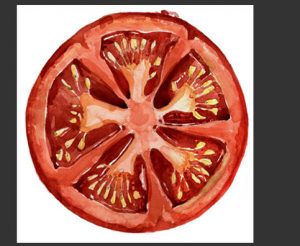Michael Pollan is an entertainer from a long line of American hucksters.
He’s not a professor, he’s a decent writer of food porn.
 (Those with the least qualifications most actively seek the perceived credibility of a title.)
(Those with the least qualifications most actively seek the perceived credibility of a title.)
When his biggest soundbite is “I’d never eat a refrigerated tomato,” the absolutism shines through like any other spoiled demagogue.
Dan Charles of NPR fell into the gotta-be-cool trap without knowing shit, but eventually admitted it.
Charles says, There’s a laboratory at the University of University of Florida, in Gainesville, that has been at the forefront of research on tomato taste. Scientists there have been studying the chemical makeup of great-tasting tomatoes, as well as the not-so-great tasting ones at supermarkets.
“There’s a lot of things wrong with tomatoes right now,” says Denise Tieman, a research associate professor there. “We’re trying to fix them, or at least figure out what’s going wrong.”
These researchers studied this refrigeration question. They looked at what happened when a tomato goes into your kitchen fridge, or into the tomato industry’s refrigerated trucks and storage rooms.
Some components of a tomato’s flavor were unaffected, such as sugars and acids. But they found that after seven days of refrigeration, tomatoes had lower levels of certain chemicals that Tieman says are really important. These so-called aroma compounds easily vaporize. “That’s what gives the tomato its distinctive aroma and flavor,” she says.
The researchers also gave chilled and unchilled tomatoes to dozens of people to evaluate, in blind taste tests, “and they could definitely tell the difference,” says Tieman. The tomatoes that weren’t chilled got better ratings.
The scientists also figured out how chilling reduced flavor; cold temperatures actually turned off specific genes, and that, in turn cut down production of these flavor compounds.
Tieman speculates that someday scientists will figure out how to keep those genes turned on, even when chilled, so the tomato industry can have it both ways: They can refrigerate tomatoes to extend shelf life, without losing flavor.
 Thankfully, chilling didn’t seem to affect nutrition – the chilled tomatoes were just as nutritious as the non-refrigerated ones.
Thankfully, chilling didn’t seem to affect nutrition – the chilled tomatoes were just as nutritious as the non-refrigerated ones.
The new findings appear in this week’s issue of the Proceedings of the National Academy of Sciences.
As significant as the results are, they probably won’t end the great tomato refrigeration debate.
“It’s not so clear cut,” says Daniel Gritzer, culinary director at SeriousEats.com, a food website. Two years ago, he did a series of blind taste tests with many different tomatoes, in New York and in California.
“Sometimes I found that the refrigerator is, in fact, your best bet,” says Gritzer.
That’s especially true for a tomato that’s already ripe and at peak flavor, he says. If you let that tomato sit on your counter, it’ll end up tasting worse.
Gritzer wrote a long blog post, detailing his results, and got a flood of reaction. “Some people wrote to say, ‘Hey, this is what I’ve always found, I’m so glad you wrote this,'” Gritzer says. “And then, a lot of people pushed back saying, ‘You’re insane, you don’t know what you’re talking about.'”
And when the hockey kids call me Doug, I say that’s Dr. Doug, I didn’t spend six years in evil hockey coaching land to be called Mister.


